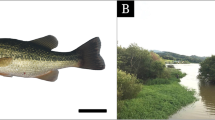Summary
The gross morphology of the maxillary gland of the adult brine shrimp, Artemia salina, was studied by light microscopy, and some features of Warren's (1938) original description of the gland were confirmed. Each gland consists of two parts: an end-sac and an efferent excretory duct. The end-sac is centrally located, and around it the efferent duct coils, making three loops before continuing as a slender terminal duct which opens to the outside via an aperture on the second maxilla. The fine structure of the end-sac epithelium is remarkably similar to that of the visceral layer of Bowman's capsule of a vertebrate nephron. The cells of the end-sac are highly branched and possess regularly arranged foot processes and junctional elements similar to “filtration slit membranes”. The cytoplasm of these cells contains numerous, membrane-bounded inclusions of unknown origin and function. On the basis of ultrastructural findings, it is postulated that formation of primary urine involves ultrafiltration.
Similar content being viewed by others
References
Anderson, E., and H. W. Beams: Light and electron microscope studies on the cells of the labyrinth in the “green gland” of Cambarus sp. Proc. Iowa Acad. Sci. 63, 681–685 (1956).
Beams, H. W., E. Anderson, and N. Press: Light and electron microscope studies on the cells of the distal portion of the crayfish nephron tubule. Cytologia (Tokyo) 21, 50–57 (1956).
Chinard, F. P.: Starling's hypothesis in the formation of edema. Bull. N. Y. Acad. Med. 38, 375–389 (1962).
—: Kidney, water, and electrolytes. Ann. Rev. Physiol. 26, 187–226 (1964).
Faith, G. C., and B. F. Trump: The glomerular capillary wall in human kidney disease: acute glomerulonephritis, systemic lupus erythematosus, and preeclampsia-eclampsia. Lab. Invest. 15, 1682–1719 (1966).
Farquhar, M. G., and G. E. Palade: Segregation of ferritin in glomerular protein absorption droplets. J. biophys. biochem. Cytol. 7, 297–304 (1960).
—, S. L. Wissig, and G. E. Palade: Glomerular permeability. I. Ferritin transfer across the normal glomerular capillary wall. J. exp. Med. 113, 47–66 (1961).
Goodrich, E. S.: The study of nephridia and genital ducts since 1895. Quart. J. micr. Sci. 86, 113–392 (1945).
Greene, C. W.: The circulatory system of the brine shrimp. Science 60, 411–412 (1924).
Hall, V.: The protoplasmic basis of glomerular ultrafiltration. Amer. Heart J. 54, 1–9 (1957).
Kirschner, L. B.: Comparative physiology: invertebrate excretory organs. Ann. Rev. Physiol. 29, 169–196 (1967).
—, and S. Wagner: The site and permeability of the filtration locus in the crayfish antennal gland. J. exp. Biol. 43, 385–395 (1965).
Kümmel, G.: Morphologischer Hinweis auf einen Piltrationsvorgang in der Antennendrüse von Cambarus affinis Say. (Crustacea, Decapoda). Naturwissenschaften 51, 200–201 (1964a).
—: Das Cölomsäckchen der Antennendrüse von Cambarus affinis Say. (Decapoda, Crustacea). Zool. Beitr. 10, 227–252 (1964b).
Lockwood, A. P. M.: The osmoregulation of Crustacea. Biol. Rev. 37, 257–305 (1962).
Luft, J. H.: Improvements in epoxy resin embedding methods. J. biophys. biochem. Cytol. 9, 409–414 (1961).
Martin, A. W.: Comparative physiology (excretion). Ann. Rev. Physiol. 20, 225–242 (1958).
Misra, R. P., and N. Kalant: Glomerular basement membrane in experimental nephrosis: chemical composition. Nephron 3, 84–102 (1966).
Pease, D. C.: Pine structures of the kidney seen by electron microscopy. J. Histochem. Cytochem. 3, 295–308 (1955).
Peters, H.: Über den Einfluß des Salzgehaltes im Außenmedium auf den Bau und die Funktion der Exkretionsorgane dekapoder Cruataceen (nach Untersuchungen an Potamobius fluviatilis und Homarus vulgaris). Z. Morph. ökol. Tiere 30, 355–381 (1935).
Pitts, R. F.: Physiology of the Kidney and Body Fluids. Chicago: Year Book Medical Publ. Inc. 1963.
Reynolds, E. S.: The use of lead citrate at high pH as an electron-opaque stain in electron microscopy. J. Cell Biol. 17, 208–212 (1963).
Rhodin, J.: Electron microscopy of the kidney. In: D. A. K. Black (ed.), Renal Disease p. 117–156. Oxford: Blackwell Sci. Publ. 1962a.
—: The diaphragm of capillary endothelial fenestrations. J. Ultrastruct. Res. 6, 171–185 (1962b).
Riegel, J. A.: Micropuncture studies of chloride concentration and osmotic pressure in the crayfish antennal gland. J. exp. Biol. 40, 487–492 (1963).
—: Micropuncture studies of the concentrations of sodium, potassium and inulin in the crayfish antennal gland. J. exp. Biol. 42, 379–384 (1965).
—: Micropuncture studies of formed-body secretion by the excretory organs of the crayfish, frog and stick insect. J. exp. Biol. 44, 379–385 (1966a).
—: Analysis of formed bodies in urine removed from the crayfish antennal gland by micropuncture. J. exp. Biol. 44, 387–395 (1966b).
—, and L. B. Kirschner: The excretion of inulin and glucose by the crayfish antennal gland, Biol. Bull. (Woods Hole) 118, 296–307 (1960).
Thump, B. F., and E. P. Benditt: Electron microscopic studies of human renal disease; observations of normal visceral glomerular epithelium and its modification in disease. Lab. Invest. 11, 753–781 (1962).
Tyson, G. E.: Gross morphology and fine structure of the maxillary gland of the brine shrimp, Artemia salina. Amer. Zool. 6, 555 (1966).
- The fine structure of the maxillary gland of the brine shrimp, Artemia salina: The efferent duct. (In manuscript) (1968).
Warren, H. S.: The segmental excretory glands of Artemia salina Linn., var. principalis Simon (the brine shrimp). J. Morph. 62, 263–297 (1938).
Yamada, E.: The fine structure of the renal glomerulus of the mouse. J. biophys. biochem. Cytol. 1, 551–566 (1955).
Author information
Authors and Affiliations
Additional information
The author is grateful to Prof. Max Alfert and Prof. Richard M. Eakin for encouragement and valuable criticism. Thanks go as well to Prof. Ralph I. Smith and Dr. Ann E. Kammer for helpful comments on the manuscript. Expert assistance in the preparation of illustrations was provided by Mrs. Emily E. Reid and Mr. Alfred A. Blaker. — This research was supported in part by USPHS Grant RG-6025 to Prof. Alfert and by a USPHS predoctoral fellowship.
Rights and permissions
About this article
Cite this article
Tyson, G.E. The fine structure of the maxillary gland of the brine shrimp, Artemia salina: The end-sac. Zeitschrift für Zellforschung 86, 129–138 (1968). https://doi.org/10.1007/BF00340363
Received:
Issue Date:
DOI: https://doi.org/10.1007/BF00340363




